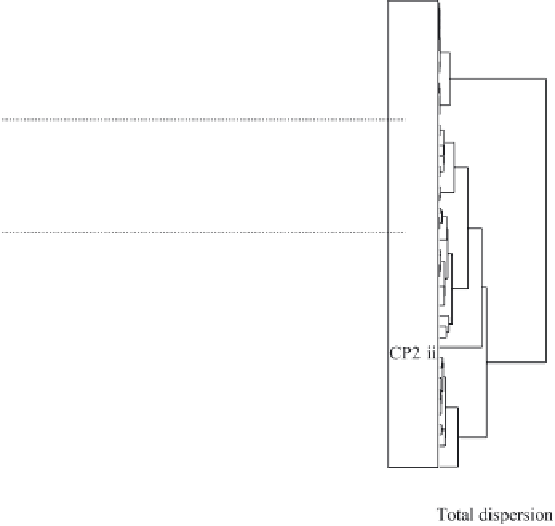Geoscience Reference
In-Depth Information
(Mesozoic-Tertiary) [Stover et al., 1996] at 465 cm and
Cretaceous Surculosphaeridinium longifurcatum at 413 cm
[Burden and Holloway, 1985].
Concentrations of various palynomorph categories are
generally constant in piston core 12 (Figure 7). The only
notable variations are the peak amounts in spores and re-
worked Mesozoic palynomorphs between 4 and 5 m, which
probably corresponds to the end of the Lake Agassiz flood.
Concentrations of organic lining of foraminifera show an
increase toward the late Holocene, which could suggest
greater carbonate dissolution or low bottom oxygen.
sites and is surrounded by forest vegetation, pollen from trees
being transported more readily by wind than pollen from
low-growing plants.
Below 900 cm (not illustrated on Figure 9), pollen assem-
blages are similar to Compass Pond (CP) pollen zones CP1
and CP2-i. Pollen zone CP1 is characterized by a dominance
of grass pollen (Poaceae), shrub (Cyperaceae, Salix, etc.),
and tundra taxa (Rumex, Artemisia). Pollen zone CP2-i rep-
resents the beginning of the Holocene in Newfoundland
[Dyer, 1986; Macpherson, 1995].
Pollen assemblages between 450 and 900 cm are charac-
terized by high total Betula percentages peaking around 600
cm, high percentages of Salix, and a gradual increase in the
proportions of tree pollen. This interval was correlated with
Compass Pond zone CP2-ii. The top of zone CP2-ii is dated
at 9.3 ka. The
14
C dates for Compass Pond (and other lakes
mentioned herein) are based on total organic carbon from
bulk sediments and are reported in Table 2.
The interval between 230 and 450 cm corresponds with
zone CP3-i based on increasing percentages of Betula pollen
and the initial peak in Abies pollen. There is a date of 7.17 ka
for the top of zone CP3-i at Compass Pond. The second peak
5.2. Pollen Zonation
5.2.1. Pollen Zones in Core 19, Notre Dame Channel. The
pollen record from core 19 (Figure 8) was compared with
three pollen records from Newfoundland lakes: Leading
Tickles [Macpherson, 1995], Small Scrape Pond [Dyer,
1986; Macpherson, 1995], and Compass Pond [Dyer, 1986;
Macpherson, 1995]. The succession of pollen assemblages at
Compass Pond is most similar to that of core 19, probably
because Compass Pond is at a higher location than the other
Figure 8.
Simplified pollen diagram for core HU87033-19P, Notre Dame Channel. Ages on the left are calibrated ages from
planktic foraminifera (asterisks) and dates from the Compass Pond pollen record with which core 19 was correlated (greater
than symbols). The dates are for the boundaries between pollen zones. Lines on the right are the results of the cluster analysis.









































Search WWH ::

Custom Search